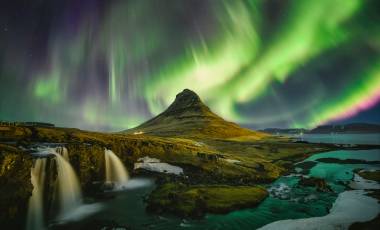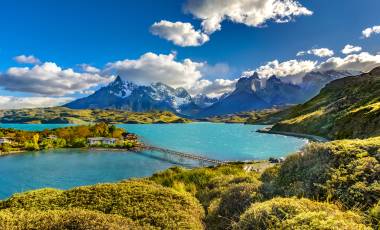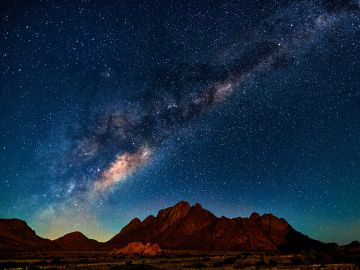
Celestial Quests: The World’s 7 Best Stargazing Experiences Led by Expert Local Guides
For centuries, the night sky has guided journeys, shaped stories and grounded communities.
What makes stargazing experiences so special today is the contrast, stepping from a world of glowing screens into stars and silence instead, where the Milky Way and constellations shine overhead, and in the right places, the Northern Lights ripple across the horizon.
On our small-group tours, these same skies become the stars of the show, shared by local guides who can explain not just what you’re seeing, but why it matters.
Here are seven of the best stargazing experiences – with detail on where to go, when to visit, and what to expect once you look up.
1. Stargazing and snowshoes in Oulanka National Park, Finland

Near the Arctic Circle in northern Finland is Oulanka National Park, a protected wilderness of pine forests, lakes, and, in winter, some of the clearest skies in northern Europe.
On our Finnish Wilderness Week adventure, our guides lead night-time snowshoe walks into the forest, with the Milky Way stretching high above. The trip is made even more special by your stay at Basecamp Oulanka, a cozy cluster of wooden lodges overlooking Juuma Lake.
Thanks to the lack of light pollution, the chances of seeing the Northern Lights ripple across the sky are good. If conditions are right, you don’t need to go far – simply step outside, look up and the magical Arctic night does the rest.
Best time: December to March, when Arctic nights are long and temperatures drop well below freezing point.

Finnish Wilderness Week
Mixed activity week in a remote part of Finland
2. Snowshoe into the hills of Skåbu, Norway, for clear, dark skies

Tucked into the Gudbrandsdalen Valley, the mountain village of Skåbu is the highest permanent settlement in Norway, ringed by Jotunheimen, Rondane and Langsua national parks. Winter defines life here – and it also delivers some of the clearest, darkest skies in Europe.
On our Cross-Country Skiing in Skåbu, Norway adventure, one evening is dedicated to a Dark Sky excursion. Your tour leader selects the clearest night, then guides you on snowshoes into the hills beyond the village. Constellations are explained through Norse mythology, navigation history and the skills Arctic communities once relied upon.
Back at the Skåbu Fjellhotell, dinner in the hotel restaurant rounds off the day – but it’s those dreamy dark skies that travelers talk about most.
Best time: December to March, when nights are long, stable and often cloudless. Free of light pollution, the constellations stand out. With the right conditions, the Northern Lights add shifting ribbons of green and violet across the Arctic night.
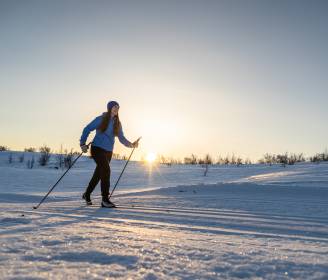
Cross-Country Skiing in Skåbu, Norway
Our guides have the inside track on all the best trails in this little known area
3. Aurora chasing and star spotting in Iceland

Iceland sits just south of the Arctic Circle, where latitude, weather and low light pollution make it one of the most reliable aurora-viewing destinations in the world.
For the best chance to see it for yourself, join our Iceland Northern Lights adventure. Our guides track real-time aurora forecasts, maximising your chances to spot the dance of the Northern Lights.
During the day, you’ll explore the Golden Circle, Diamond Beach and roaring waterfalls. But at night, your Exodus guide leads the way outside. If the aurora appears, you’ll see for yourself why the dancing lights were considered omens or messages from the gods in Icelandic folklore.
Best time: September to March, when darkness lasts long enough for magnificent displays.

Iceland Northern Lights
Visit Iceland in search of the aurora borealis, tumbling waterfalls and glittering glaciers
4. Bedouin camping under the stars in Wadi Rum, Jordan

Wadi Rum in southern Jordan is a UNESCO-protected desert valley of sandstone mountains and sweeping red sands. Far from the glow of Amman, it offers some of the clearest skies in the Middle East.
On many of our Jordan tours, we stay in a remote Wadi Rum desert camp, run by a local Bedouin family. It’s used exclusively by our travelers so you can soak up the magic of the desert – just you, your group and the night skies.
Staying here, you’re perfectly positioned to watch the stars emerge as the fire dies down. Your Exodus tour leader explains how constellations once guided caravans traveling between Petra and Arabia. With cardamom tea in hand and silence all around, the desert sky becomes a lesson in history as much as astronomy.
Best time: In the cooler months, October to April, when dry air and cloudless nights reveal the Milky Way stretching from horizon to horizon. Constellations such as Scorpio and Sagittarius rise in the south, and meteor showers often send streaks across the sky.
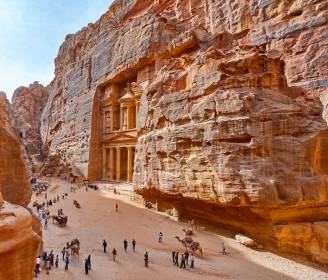
A Week in Jordan
From Amman to the Dead Sea via Petra and the Wadi Rum desert, visit Jordan's essential stops
5. Ger camping beneath Mongolia’s vast skies
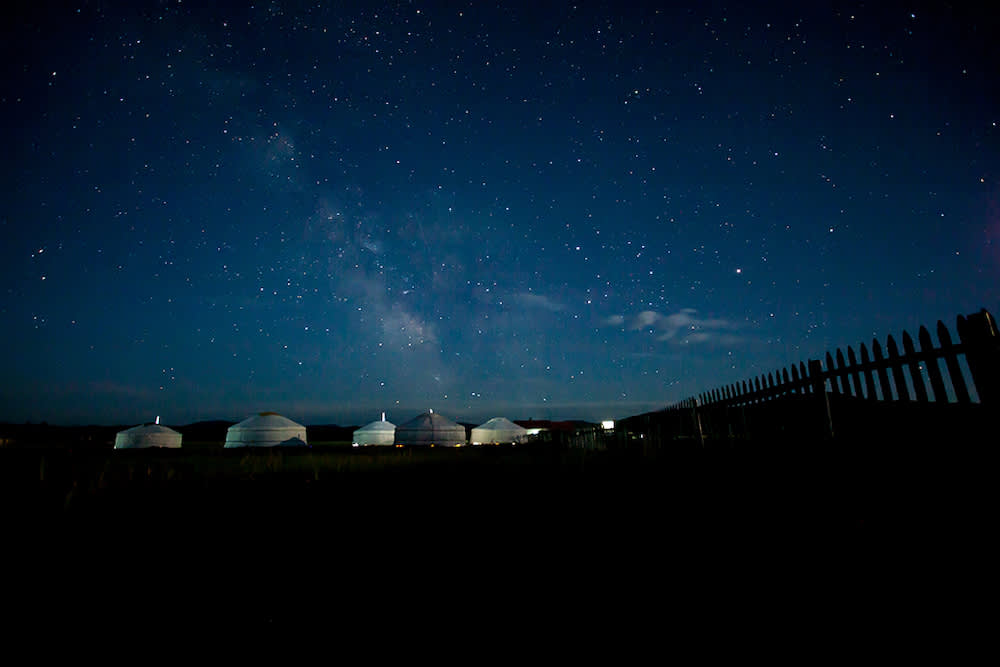
Mongolia is one of the least densely populated countries in the world – and with that comes some of the darkest skies. On the central steppe, the vast grassland plain that has shaped nomadic life for centuries, horizons are flat and unbroken, creating an almost perfect dome of stars.
On our Discover Mongolia adventure, you’ll stay at traditional ger camps. These round, felt tents are simple but atmospheric, usually with a central wood-burning stove to keep you warm on cool nights, and they allow you to experience the life of a nomadic culture.
But the real highlight comes after dark. Step outside with your local guide, who points out the constellations blazing overhead and explains how the Milky Way was once used to time migrations across the open steppe. It’s a night sky as practical as it is beautiful – read and retold through generations.
Best time: In summer, June to September,when dry air and long evenings give unobstructed views. You can spot the Milky Way and southern constellations like Sagittarius and Aquila, while the Andromeda Galaxy is visible to the naked eye.
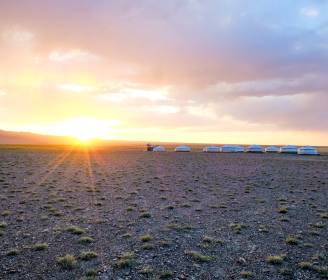
Discover Mongolia
Journey through Mongolia's vast lands dotted by nomadic camps
6. Searching for the Southern Cross in Patagonia

At the far south of South America, Patagonia straddles Chile and Argentina – a land of glaciers and granite towers. It’s also home to some of the clearest skies in the south.
The southern hemisphere reveals unique treasures: the Southern Cross bright on the horizon, the Magellanic Clouds (two nearby galaxies) faint but visible to the naked eye, and the Coal Sack Nebula darkening the Milky Way’s glow.
Whether in Torres del Paine or beneath Mount Fitz Roy on our Discover Patagonia adventure, your Exodus tour leader knows the valleys sheltered from Patagonia’s winds. There, reflections in glacial lakes double the view.
Best time: April to September, when long nights and sharp cold fronts strip the skies clear.

Discover Patagonia
Discover spectacular southern Chile and Argentina
7. Celestial Navigation in the NamibRand Nature Reserve, Namibia

In Namibia’s NamibRand Nature Reserve – one of the first certified International Dark Sky Reserves in Africa – there is virtually no light pollution, just an endless sea of desert, dunes and stars.
The southern hemisphere sky reveals unique sights: the Southern Cross bright to the south, the Magellanic Clouds faint but visible, and the dense heart of the Milky Way arching overhead. Shooting stars are frequent, and with binoculars, clusters like Omega Centauri appear as glowing spheres.
On our Discover Namibia camping adventure, nights in desert lodges and tented camps offer stargazing without even leaving your room. Step outside and your tour leader points out constellations once read by San hunter-gatherers, explaining how desert communities used the night sky as both map and calendar.
Best time: The dry winter months, May to September, when nights are long and crystal clear.

Botswana & Namibia: Delta & Dunes
Wildlife and contrasting landscapes of Botswana and Namibia
A universe of stargazing experiences
From Norway’s winter plateaus to Namibia’s desert south, these stargazing experiences shift the journey from landscape to cosmos. These skies aren’t just beautiful – they’re part of each place’s story. Find your adventure below.





